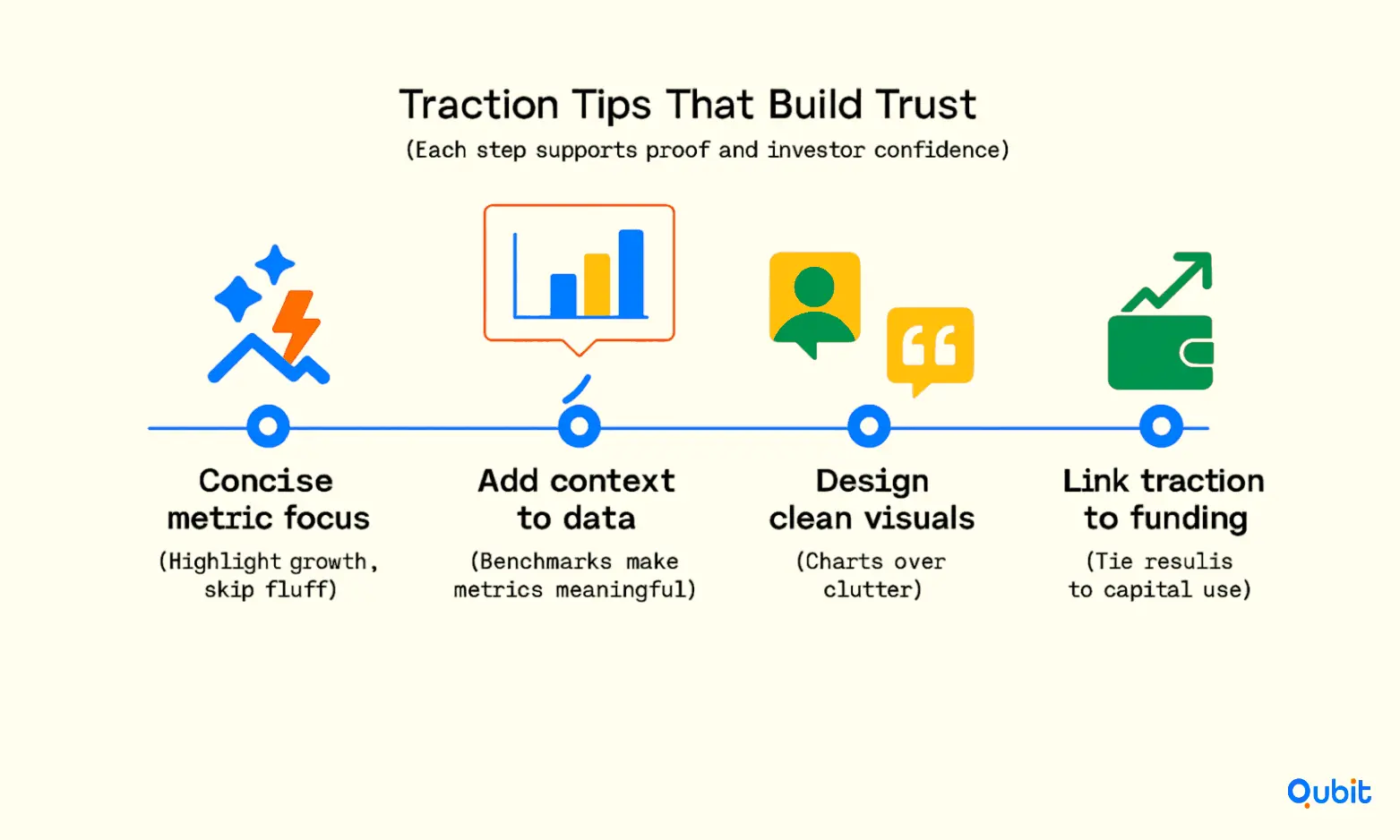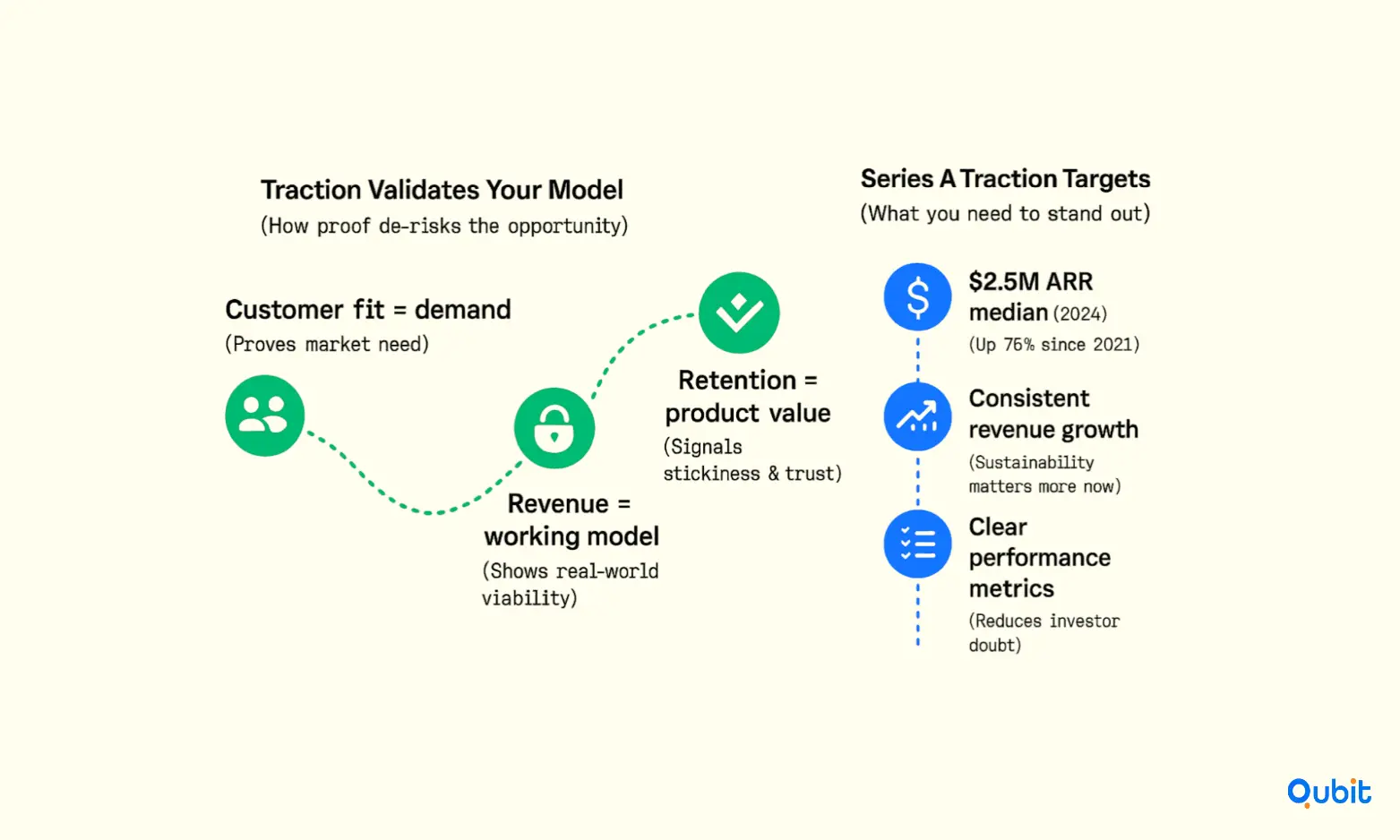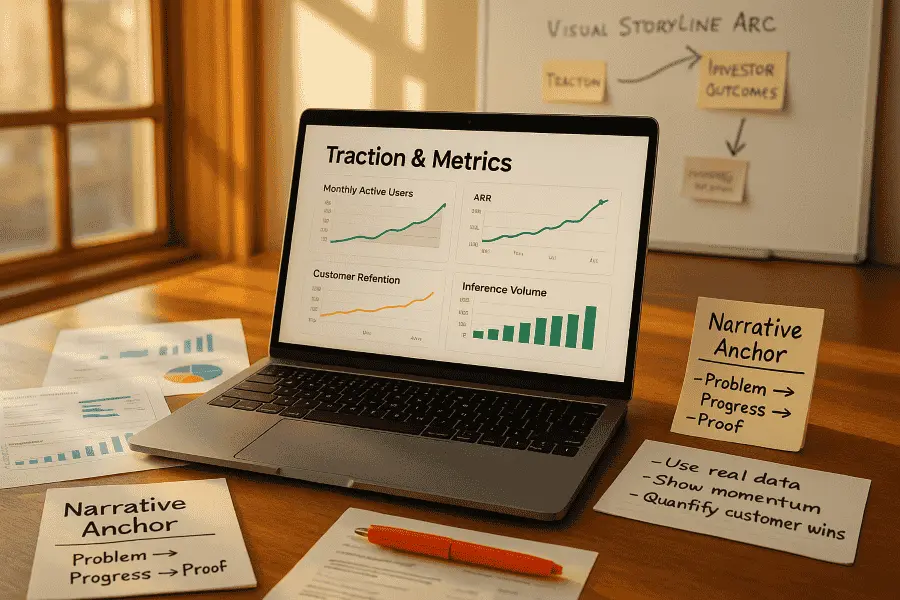Investor confidence in AI startups hinges on more than just groundbreaking ideas, it’s about demonstrating tangible progress, backed by compelling data and a clear vision. Startups that can showcase traction through measurable metrics and weave these into a persuasive narrative often stand out in competitive fundraising environments.
A comprehensive overview of fundraising approaches appears in how to raise money for AI startup, offering a broad framework that complements the specific tactics discussed here.
This blog explores actionable strategies to help AI startups build investor trust by combining data-driven insights with storytelling. From showcasing growth metrics to crafting a narrative that resonates, we’ll uncover how these elements can secure funding and drive long-term success.
Mastering Traction Metrics: Define and Measure What Matters
Traction, defined as quantitative evidence of market demand and product-market fit, serves as a critical indicator for investors assessing a business's potential. By focusing on meaningful metrics like revenue growth, customer engagement, and unit economics, startups can effectively showcase their progress and avoid the pitfalls of vanity numbers.
Prioritizing Metrics That Matter
Investors increasingly value metrics that reflect sustainable business outcomes over superficial figures. Revenue growth, for instance, provides a direct measure of financial performance and scalability. Similarly, customer engagement metrics, such as retention rates and active user counts, highlight the strength of a product's connection with its audience.
Unit economics, another vital metric, evaluates profitability at the individual customer level. Accurate projections of customer acquisition costs (CAC) and lifetime value (LTV) can significantly bolster investor confidence. For insights into crafting precise financial forecasts, startups can explore strategies outlined in accurate financial projections.
Moving Beyond Vanity Metrics
The shift from vanity metrics to meaningful traction indicators is reshaping how startups present their growth stories. Vanity metrics, such as social media followers or app downloads, often lack depth and fail to convey the true health of a business. Instead, focusing on actionable metrics like monthly recurring revenue (MRR) or trial-to-paid conversion rates can provide a clearer picture of progress.
For example, a startup that grew its active user base from 2,000 to 10,000 within six months, achieving a 35% month-over-month growth rate and a 20% trial-to-paid conversion, demonstrates tangible traction. This type of growth story resonates with investors seeking evidence of product-market fit and scalability.
Trends in Investor Expectations
Investor selectiveness has increased significantly, with a growing emphasis on metrics that showcase meaningful business outcomes. Startups that clearly communicate their traction metrics stand out in competitive funding environments. This trend underscores the importance of presenting data that aligns with investor priorities, such as revenue growth and customer engagement.
For additional strategies on quantifying performance metrics, startups can explore quantifying AI startup ROI for investors, which connects measurable outcomes with investor confidence.
Winning Traction Narrative: Tips & Best Practices
A well-crafted traction story can be the difference between a pitch that resonates and one that falls flat. For founders, it’s not just about showcasing numbers; it’s about presenting a narrative that de-risks the investment opportunity while captivating potential investors. A strong traction story is concise, visually engaging, and backed by real-world validations.

1. Keep It Concise and Impactful
Investors often sift through numerous pitches, so brevity is key. Your traction story should deliver its message in a few impactful sentences or visuals. Focus on the highlights, metrics that demonstrate growth, customer adoption, or market validation. Avoid overwhelming your audience with excessive data. Instead, prioritize clarity and relevance.
For example, if your startup has achieved a 200% increase in monthly recurring revenue (MRR) over the past six months, lead with that. Pair it with a visual representation, such as a growth chart, to make the data instantly digestible. Tools like PITCHES.AI can help generate sample visuals and data-driven story arcs for your traction slide, ensuring your presentation is both professional and compelling.
2. Use Contextual Metrics to Tell the Story
Numbers alone don’t tell the full story. Contextualizing your metrics helps investors understand their significance. For instance, if your product has 10,000 active users, explain how this compares to industry benchmarks or your competitors. Did you achieve this milestone faster than others in your space? Are your customer acquisition costs (CAC) lower than the industry average?
Context transforms raw data into a narrative. It shows not just where your startup is but also where it’s headed. This approach reassures investors that your growth is sustainable and rooted in a solid strategy.
3. Integrate Customer Testimonials and Real-Life Validations
Nothing builds credibility like the voice of your customers. Testimonials, case studies, or user success stories can humanize your traction narrative. They provide tangible proof that your product solves real problems and delivers value.
For instance, if a customer’s testimonial highlights how your solution saved their business time or money, include it in your pitch. Pair this with a metric that quantifies the impact, such as “reduced operational costs by 30%.” This combination of qualitative and quantitative evidence strengthens your story.
4. Design Visuals That Speak Volumes
A picture is worth a thousand words, especially in a pitch deck. Visuals like charts, graphs, and infographics can simplify complex data and make your traction story more engaging. Ensure your visuals are clean, easy to interpret, and aligned with your brand.
When designing your traction slide, focus on one or two key visuals that highlight your most impressive metrics. Avoid cluttering the slide with too much information. Instead, let the visuals guide the narrative.
5. Align Your Traction Story with Fund Usage
A strong traction narrative is further reinforced by transparent fund allocation. Investors want to see how their capital will fuel your growth. For insights on structuring your budget effectively, explore our guide on AI startup use of funds budgeting for investors. This resource highlights how precise budgeting strategies can build investor trust and complement your traction story.
Customization for Your Startup’s Traction Metrics
Every startup is unique, and its traction metrics should reflect that individuality. Customized traction metrics are essential to accurately showcase progress and potential, especially when considering the startup’s industry, stage of development, and business model. A one-size-fits-all approach to metrics can obscure the true narrative of a startup’s growth, making it harder to resonate with investors and stakeholders.
Why Customization Matters
The metrics that matter most to a startup in its early stages often differ significantly from those relevant to a more mature company. For instance, a pre-revenue startup might focus on user acquisition rates or engagement metrics, while a later-stage company would prioritize revenue growth or customer retention. Tailoring these metrics ensures that the data presented aligns with the expectations of the audience and reflects the startup’s current priorities.
Industry-specific metrics also play a critical role. A SaaS startup might emphasize monthly recurring revenue (MRR) or churn rates, while an e-commerce business could highlight average order value (AOV) or cart abandonment rates. By focusing on metrics that are directly tied to the startup’s operational model, founders can provide a clearer picture of their market position and scalability.
Aligning Metrics with Developmental Stages
Startups evolve through distinct stages, and each phase demands a different set of metrics to measure success. During the ideation and validation phase, qualitative feedback and early user adoption may take precedence. As the startup moves into growth and scaling, metrics like customer acquisition cost (CAC) and lifetime value (LTV) become more relevant.
To identify which metrics matter most at each stage, founders can reference tools like Founders Cipher, a comprehensive 53-page guide that distills insights from 700 investor questions. This resource helps startups pinpoint the metrics that resonate with investors and align with their current stage of development.
Crafting a Compelling Narrative
Metrics are more than just numbers—they tell a story. When tailored to the startup’s unique context, they provide a compelling narrative that highlights progress, identifies challenges, and outlines opportunities. For example, a startup in the health tech industry might use metrics to demonstrate how its solution improves patient outcomes, while a fintech company could focus on transaction volume growth to showcase market adoption.
Tailoring traction metrics is not just a strategic choice—it’s a necessity. Industry-specific and stage-specific metrics provide insights that are both meaningful and actionable, ensuring that startups present a clear and accurate picture of their growth journey. By focusing on the right data, founders can strengthen their pitch, attract the right investors, and set the foundation for sustainable success.
Driving Momentum: Pairing Steady Traction with Growth
Building investor confidence requires more than just a promising pitch; it demands measurable and consistent progress. Combining steady traction with strong momentum metrics creates a compelling narrative of sustainable growth. By focusing on key indicators such as month-over-month (MoM) growth, retention rates, and customer acquisition costs (CAC) relative to lifetime value (LTV), businesses can demonstrate their potential for long-term success.
The Role of Momentum Metrics in Investor Trust
Momentum metrics are the heartbeat of a growing business. They provide a snapshot of how well a company is scaling and retaining its customer base. For instance, MoM growth highlights the pace at which revenue or user acquisition is expanding. A consistent upward trajectory in this metric signals to investors that the business is not only growing but doing so at a predictable rate.
Equally important are retention rates and churn. High retention rates indicate that customers find ongoing value in the product or service, while low churn reflects customer satisfaction and loyalty. Together, these metrics paint a picture of stability, which is critical for securing investor trust.
Balancing Growth with Efficiency
While growth is essential, efficiency in achieving that growth is equally important. This is where the CAC-to-LTV ratio comes into play. A low CAC relative to a high LTV demonstrates that a business is acquiring customers cost-effectively while maximizing their lifetime value. This balance reassures investors that the company is not overspending to achieve growth and has a sustainable model in place.
Real-World Example: SaaS Startup
Consider the case of a SaaS startup with 1,500 paying customers, a 12% MoM revenue growth rate, and a customer churn rate below 3%. These figures illustrate a business that is not only scaling rapidly but also retaining its customer base effectively. The combination of strong growth and low churn builds a narrative of sustainable momentum, making the company an attractive prospect for investors.
Why Consistency Matters
Consistency in these metrics is what sets apart businesses that thrive from those that falter. A single quarter of impressive growth may catch attention, but sustained performance over time builds trust. Investors are more likely to back a company that demonstrates steady progress rather than one with sporadic spikes in performance.
Momentum metrics, when paired with a clear growth strategy, can transform how a business is perceived. By focusing on measurable indicators like MoM growth, retention rates, and CAC-to-LTV ratios, companies can showcase their potential for sustainable success.
Why Traction Matters: Proving Your Business Model
Traction is more than just a buzzword, it’s the backbone of a startup’s credibility. Demonstrating robust traction validates your business model and reassures investors that your company is on a sustainable path. For startups seeking funding, traction serves as a critical differentiator, showcasing tangible proof of market demand and reducing investment risk.

The Role of Traction in Business Validation
Traction is the clearest indicator that your business model works. It reflects how well your product or service resonates with your target audience and whether your revenue streams are scalable. Investors increasingly prioritize traction as a key metric for assessing a startup’s viability. A compelling traction story, grounded in hard metrics and an authentic narrative, can make the difference between securing funding and being overlooked.
Key Benchmarks That Define Traction
Investors are raising the bar for traction benchmarks, especially at pivotal funding stages like Series A. For instance, median Series A companies are expected to show at least $2.5M in ARR (Annual Recurring Revenue). This figure has surged by 75% since 2021, reflecting the growing investor expectations around Series A traction. These benchmarks highlight the importance of demonstrating not just growth but sustainable performance.
Emerging trends also show that investors now demand higher ARR and solid performance metrics. This shift underscores the significance of traction as a cornerstone for modern funding decisions. Startups that meet or exceed these benchmarks are better positioned to attract capital and stand out in competitive markets.
Reduces Investment Risk
Traction mitigates investment risk by offering proof of concept. When a startup demonstrates consistent revenue growth, customer retention, and market demand, it reassures investors that the business model is viable. Clear performance benchmarks, such as the $2.5M ARR expectation, act as a safety net, reducing uncertainty and making the investment more appealing.
For founders, focusing on traction is not just about meeting investor demands—it’s about building a sustainable business. By aligning your growth strategy with industry benchmarks, you can validate your business model and differentiate yourself from competitors.
Future Trends in Traction: Market Outlook and Evolving Metrics
The dynamics of traction metrics are undergoing a significant transformation as startups adapt to shifting investor priorities. Emerging trends emphasize capital efficiency, customer retention, and clear pathways to profitability, reshaping how businesses measure and achieve sustainable growth.
Capital Efficiency: A Core Metric
Startups are increasingly prioritizing capital efficiency, focusing on maximizing returns from every dollar spent. This shift reflects investor demand for disciplined spending and measurable outcomes. Companies that demonstrate the ability to scale without excessive capital infusion are gaining a competitive edge in funding rounds.
Customer Retention: The New Growth Indicator
Customer retention is becoming a cornerstone of traction metrics. Investors are scrutinizing metrics like churn rates and lifetime value (LTV) to assess the sustainability of a startup’s growth. AI-powered tools are enabling businesses to predict customer behavior and personalize experiences, driving higher retention rates and long-term profitability.
Profitability as a Strategic Goal
Profitability is no longer a distant milestone but a near-term objective for many startups. Clear pathways to profitability are essential for securing investor confidence. Companies are adopting vertical-specific strategies to align their operations with market demands, ensuring a faster transition from growth to profitability.
AI Startups Leading Innovation
AI-driven startups are at the forefront of these evolving metrics. By leveraging advanced analytics and predictive modeling, they are redefining how businesses measure traction. These innovations are not only enhancing operational efficiency but also providing investors with deeper insights into a startup’s potential for sustainable growth.
Investor expectations are evolving rapidly, with selectivity becoming a defining characteristic of funding allocation. Startups that align their metrics with these emerging trends are better positioned to secure investment and thrive in competitive markets.
Building Your Narrative: Integrating Story with Metrics
A well-crafted investor narrative can transform a pitch into a memorable story. By blending the startup's origin, its problem-solution framework, and its vision for the future, founders can create a personalized connection with investors. When this narrative is paired with quantitative metrics—such as growth rates or customer acquisition costs—it becomes a powerful tool. This integration not only highlights the startup's traction story but also demonstrates its potential for scalability. Together, storytelling and data create a balanced, persuasive investment case.
Conclusion
Defining actionable traction metrics and weaving them into a compelling traction narrative is essential for building investor confidence. By presenting a data-driven pitch, entrepreneurs can effectively demonstrate the potential of their business while reducing perceived risks for investors. This approach not only highlights the startup's growth trajectory but also establishes credibility, making it easier to secure funding.
We encourage you to adopt these strategies in your fundraising efforts to create a lasting impact. At Qubit Capital, we specialize in helping businesses refine their investor outreach strategies. If you're ready to elevate your pitch and connect with the right investors, explore our Investor Outreach services today.
Key Takeaways
- AI startups must integrate both trending and realized ROI to attract investment.
- Establishing clear baselines and continuous monitoring is essential for accurate ROI measurement.
- Real-world examples and standardized templates add credibility to ROI claims.
- Overcoming common challenges requires robust data quality and strategic alignment with business goals.
- A compelling, narrative-driven ROI demonstration differentiates your startup in competitive funding discussions.
Frequently asked Questions
What are the key traction metrics for AI startups?
Key traction metrics for AI startups include revenue growth, user acquisition rates, customer engagement levels, and unit economics such as Customer Acquisition Cost (CAC) versus Lifetime Value (LTV). These indicators provide tangible proof of market demand and the startup’s ability to scale effectively.


 Back
Back



